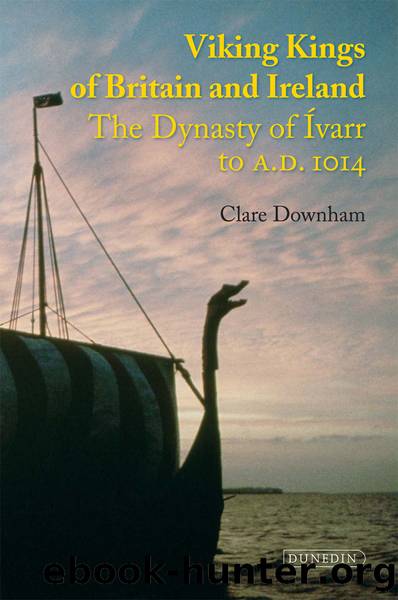Viking Kings of Britain and Ireland by Clare Downham

Author:Clare Downham
Language: eng
Format: epub
Publisher: Dunedin Academic Press Ltd
Published: 2013-08-14T16:00:00+00:00
Galloway
The coasts of Galloway adjoin the North Channel of the Irish Sea. It was therefore of great geographical significance to the viking-rulers of Man and the Isles, whose power was premised on regular contact along this route.213 Written sources for the political history of Galloway are lacking from the 830s until the earlier eleventh century.214 For the year 1034, ‘The Annals of Ulster’ record the death of Suibne mac Cinaeda, rí Gallgaidhel (‘king of Galloway’). 215 This suggests that the area was ruled independently. A close connection with Man and the Isles is also witnessed during the eleventh century. Echmarcach son of Røgnvaldr is recorded as king of the Rhinns of Galloway at his death in 1064.216 He was a member of the dynasty of Ívarr who ruled Dublin and the Isles intermittently until 1061.217 Benjamin Hudson has identified Echmarcach as one of the three kings from North Britain who submitted to Knútr, king of England in 1031.218 This suggests a long-lived Echmarcach’s wider involvement in the politics of North Britain; he may have already had a foothold in the Rhinns and been a rival to Suibne mac Cinaeda.219
The borders of Galloway are not clear for the period under discussion.220 References in Irish texts might hint that Galloway included lands to the north and some of the Inner Hebrides.221 Nevertheless there is uncertainty as to whether places said to be within the lands of the Gall-goídil refer to the general culture of an area rather or mark the boundaries of a specific polity. The name Galloway is derivative of the Gaelic term Gall-goídel (‘Foreigner-Gael’).222 The form of the name can be best explained by the term Gall-goídel having first passed through the mouths of Brittonic-speakers (perhaps from within the region of Galloway or Strathclyde) who might render it Gallwyddel.223 This was later anglicised to Galloway.224 The label Gall-goídel indicates that the inhabitants of Galloway were at one point identified as being of mixed Gaelic and Scandinavian culture or ethnicity.
The early activities of vikings in Galloway may be witnessed by the archaeological evidence. The excavations at Whithorn, directed by Peter Hill, indicate that the church was destroyed by fire in the 840s.225 Some ecclesiastical buildings were restored in the late ninth century, but these were demolished in the following century.226 Within this context it is relevant to note the deposition of a mixed hoard at Talnotrie in Kirkudbrightshire around 875. Some of its content would appear to have passed through viking-hands, including two fragments of Kufic coins and a fragment of a Frankish denier.227 There are also non-silver objects which make the hoard unusual.228 Graham-Campbell has concluded that the hoard belonged to a Northumbrian or Galwegian metal-worker.229 Nevertheless, it is possible that vikings were responsible for its deposition. The hoard’s date corresponds with the North-British campaigns of Hálfdan, brother of Ívarr. 230
The date of the Talnotrie hoard also corresponds with the supposed time of arrival of the relics of St Cuthbert in Whithorn. This assertion is found in the early twelfth-century Historia Dunelmensis Ecclesiae.
Download
This site does not store any files on its server. We only index and link to content provided by other sites. Please contact the content providers to delete copyright contents if any and email us, we'll remove relevant links or contents immediately.
| Africa | Americas |
| Arctic & Antarctica | Asia |
| Australia & Oceania | Europe |
| Middle East | Russia |
| United States | World |
| Ancient Civilizations | Military |
| Historical Study & Educational Resources |
Magic and Divination in Early Islam by Emilie Savage-Smith;(1500)
Ambition and Desire: The Dangerous Life of Josephine Bonaparte by Kate Williams(1346)
Bohemians, Bootleggers, Flappers, and Swells: The Best of Early Vanity Fair by Bohemians Bootleggers Flappers & Swells- The Best of Early Vanity Fair (epub)(1344)
Papillon by Henry Charrière(1310)
Twelve Caesars by Mary Beard(1258)
Operation Vengeance: The Astonishing Aerial Ambush That Changed World War II by Dan Hampton(1137)
What Really Happened: The Death of Hitler by Robert J. Hutchinson(1131)
London in the Twentieth Century by Jerry White(1114)
Time of the Magicians by Wolfram Eilenberger(1089)
The Japanese by Christopher Harding(1086)
Twilight of the Gods by Ian W. Toll(1084)
Lenin: A Biography by Robert Service(1045)
The Devil You Know by Charles M. Blow(985)
A Social History of the Media by Peter Burke & Peter Burke(938)
Freemasons for Dummies by Hodapp Christopher;(923)
Napolean Hill Collection by Napoleon Hill(903)
Henry III by David Carpenter;(892)
The Churchill Complex by Ian Buruma(884)
The Rise and Triumph of the Modern Self by Unknown(880)
